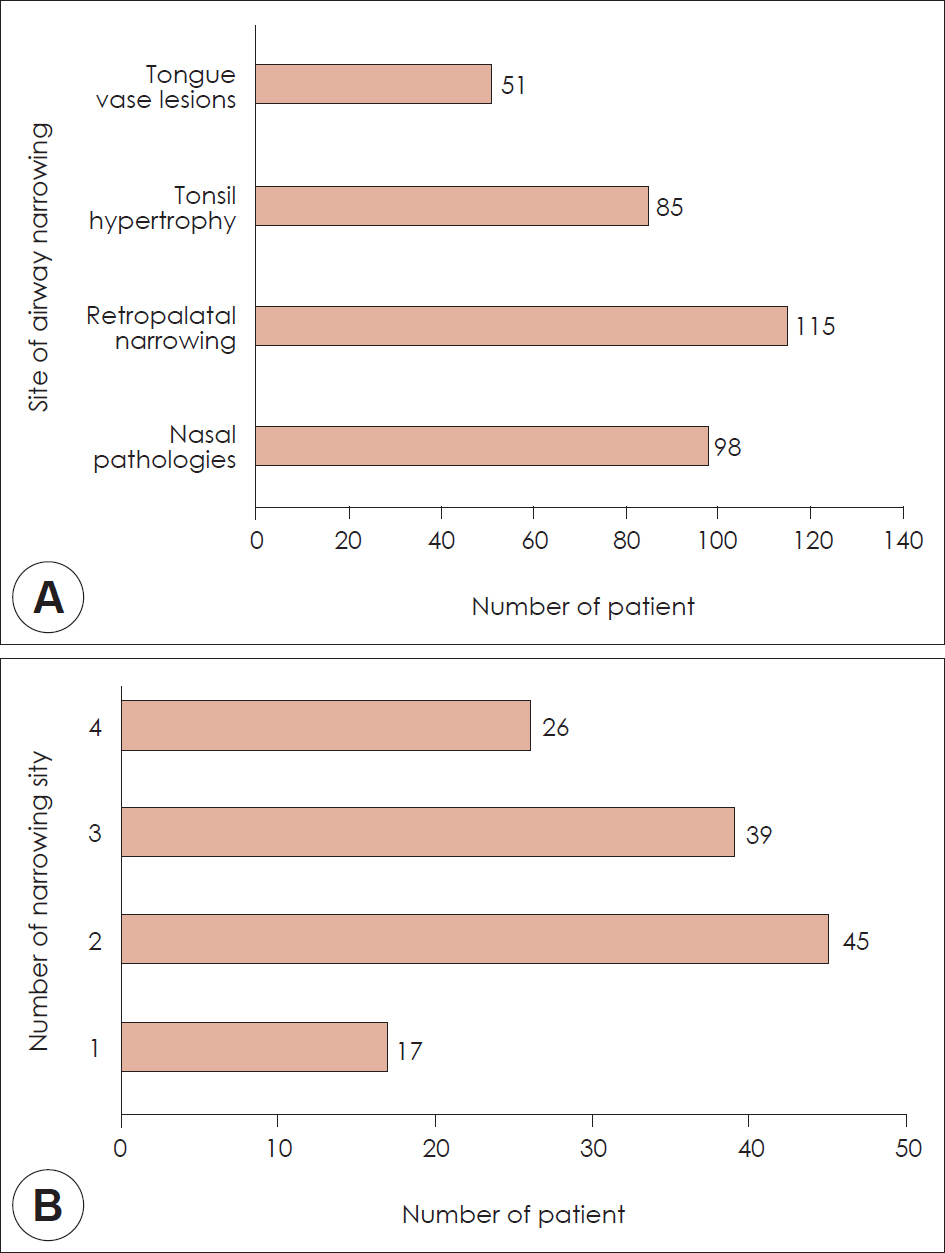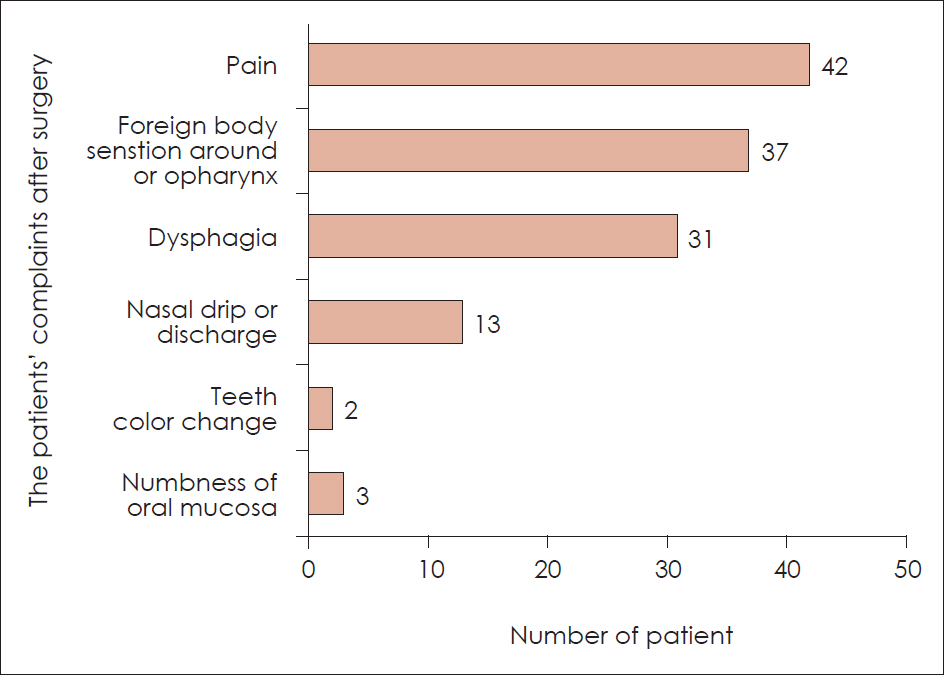J Rhinol.
2017 May;24(1):20-25. 10.18787/jr.2017.24.1.20.
Study for Clinical Efficacy of Sleep Surgery in Treatment of Patients with Moderate-Severe Obstructive Sleep Apnea
- Affiliations
-
- 1Department of Otolaryngology, National Police Hospital, Seoul, Korea.
- 2Department of Otorhinolaryngology-Head and Neck Surgery, Chung-Ang University College of Medicine, Seoul, Korea.
- 3Department of Otorhinolaryngology, Seoul National University College of Medicine, Seoul, Korea. hyunjerry@snu.ac.kr
- KMID: 2379785
- DOI: http://doi.org/10.18787/jr.2017.24.1.20
Abstract
- BACKGROUND AND OBJECTIVES
Surgical treatment is considered as a secondary treatment option for obstructive sleep apnea (OSA). This study was performed to determine whether surgical treatment can be considered in patients with moderate-severe OSA as a treatment modality.
MATERIALS AND METHODS
A total of 127 patients with moderate-severe OSA were retrospectively enrolled. The anatomic narrowing sites were mainly evaluated using cephalometry and drug induced sleep endoscopy (DISE), and then multi-level surgeries were performed.
RESULTS
Both uvula and soft palate were the most frequent narrowing sites and a total of 110 patients showed upper airway narrowing more than two anatomic structures. A total of 79 patients (62.1%) were categorized as responders and 48 patients (39.1%) were non-responders. After multi-level sleep surgeries, patients' subjective symptoms and sleep parameters were significantly improved. However, AHI was not considerably decreased. Non-responders to sleep surgeries showed relatively higher rates of severe OSA and body mass index. Tongue base narrowing, incomplete corrections of nasal pathologies and soft palate were significant factors for lower success rates.
CONCLUSION
We estimate that sleep surgery might be a therapeutic option for moderate to severe patients with OSA. A delicate pre-operative evaluation for upper airway narrowing is necessary to adapt sleep surgery to these patients.
MeSH Terms
Figure
Reference
-
1). Somers VK, Mark AL, Zavala DC, Abboud FM. Contrasting ef-fects of hypoxia and hypercapnia on ventilation and sympathetic activity in humans. Journal of Applied Physiology. 1989; 67(5):2101–6.
Article2). Marshall NS, Wong KK, Liu PY, Cullen SR, Knuiman MW, Grunstein RR. Sleep apnea as an independent risk factor for all-cause mortality: the Busselton Health Study. Sleep. Aug. 2008; 31(8):1079–85.3). Young T, Finn L, Peppard PE, Szklo-Coxe M, Austin D, Nieto FJ, et al. Sleep disordered breathing and mortality: eighteen-year follow-up of the Wisconsin sleep cohort. Sleep Aug. 2008; 31(8):1071–8.4). Liu Y, Park YC, Lowe AA, Fleetham JA. Supine Cephalometric Analyses of an Adjustable Oral Appliance Used in the Treatment of Obstructive Sleep Apnea. Sleep Breath. 2000; 4(2):59–66.
Article5). Weaver TE, Maislin G, Dinges DF, Bloxham T, George CF, Green-berg H, et al. Relationship between hours of CPAP use and achieving normal levels of sleepiness and daily functioning. Sleep Jun. 2007; 30(6):711–9.
Article6). Epstein LJ, Kristo D, Strollo PJ Jr, Friedman N, Malhotra A, Patil SP, et al. Clinical guideline for the evaluation, management and long-term care of obstructive sleep apnea in adults. Journal of clinical sleep medicine: JCSM: official publication of the American Academy of Sleep Medicine. 2009; 5(3):263–76.7). Gillespie MB, Reddy RP, White DR, Discolo CM, Overdyk FJ, Nguyen SA. A trial of drug-induced sleep endoscopy in the surgical management of sleep-disordered breathing. The Laryngoscope Jan. 2013; 123(1):277–82.
Article8). Sher AE, Schechtman KB, Piccirillo JF. The efficacy of surgical modifications of the upper airway in adults with obstructive sleep apnea syndrome. Sleep. 1996; 19(2):156–77.
Article9). Fujita S, Conway W, Zorick F, Roth T. Surgical correction of anatomic azbnormalities in obstructive sleep apnea syndrome: uvulopalatopharyngoplasty. Otolaryngology–head and neck surgery: official journal of American Academy of Otolaryngology-Head and Neck Surgery. 1981; 89(6):923–34.10). Zerpa Zerpa V, Carrasco Llatas M, Agostini Porras G, Dalmau Ga-lofre J. Drug-induced sedation endoscopy versus clinical exploration for the diagnosis of severe upper airway obstruction in OSAHS patients. Sleep Breath. 2015; 19(4):1367–72.
Article11). Farrokhyar F, Karanicolas PJ, Thoma A, Simunovic M, Bhandari M, Devereaux PJ, et al. Randomized controlled trials of surgical inter-ventions. Annals of Surgery. 2010; 251(3):409–16.
Article12). Kezirian EJ, Weaver EM, Criswell MA, de Vries N, Woodson BT, Piccirillo JF. Reporting results of obstructive sleep apnea syndrome surgery trials. Otolaryngology–head and neck surgery: official journal of American Academy of Otolaryngology-Head and Neck Surgery. 2011; 144(4):496–9.
Article13). Browaldh N, Nerfeldt P, Lysdahl M, Bring J, Friberg D. SKUP3 randomised controlled trial: polysomnographic results after uvulopalatopharyngoplasty in selected patients with obstructive sleep apnoea. Thorax. 2013; 68(9):846–53.14). Lin HC, Friedman M, Chang HW, Gurpinar B. The efficacy of multilevel surgery of the upper airway in adults with obstructive sleep apnea/hypopnea syndrome. The Laryngoscope. 2008; 118(5):902–8.
Article15). Steward DL, Weaver EM, Woodson BT. Multilevel temperature-controlled radiofrequency for obstructive sleep apnea: extended follow-up. Otolaryngology–head and neck surgery: official journal of American Academy of Otolaryngology-Head and Neck Surgery. 2005; 132(4):630–5.
Article16). Friedman M, Lin HC, Gurpinar B, Joseph NJ. Minimally invasive single-stage multilevel treatment for obstructive sleep apnea/hypopnea syndrome. The Laryngoscope. 2007; 117(10):1859–63.
Article17). Gasparini G, Torroni A, Di Nardo F, Pelo S, Foresta E, Boniello R, et al. OSAS surgery and postoperative discomfort: phase I surgery versus phase II surgery. Bio Med Research International. 2015; 2015:439847.
Article18). Shin SH, Ye MK, Kim CG. Modified uvulopalatopharyngoplasty for the treatment of obstructive sleep apnea-hypopnea syndrome: resection of the musculus uvulae. Otolaryngology–head and neck surgery: official journal of American Academy of Otolaryngology-Head and Neck Surgery. 2009; 140(6):924–9.
Article
- Full Text Links
- Actions
-
Cited
- CITED
-
- Close
- Share
- Similar articles
-
- A Case of REM-Dependent Obstructive Sleep Apnea Syndrome
- Surgical Treatment of Adult Obstructive Sleep Apnea
- The Role of Endothelin-1 in Obstructive Sleep Apnea Syndrome and Pulmonary Hypertension
- A Case of Huge Lingual Tonsillar Hypertrophy Causing Obstructive Sleep Apnea in Adult
- Pathogenesis of Obstructive Sleep Apnea





